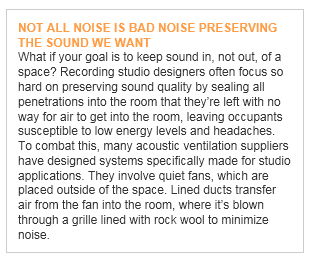Before we can determine how to keep noise to a minimum, we must first look at how sound travels. It all starts with movement, whether it's our vocal cords vibrating as we speak, a bell ringing or the inner workings of a radio speaker system.
When one of these objects moves within a space, it creates a vibration in the air around it. This vibration forces air particles in the surrounding area to move away from the source of the vibration. These air particles, in turn, travel in the form of sound waves. When they reach your ear, they transfer the initial vibration to your eardrums, which the mind translates into sound. Everything from the size and shape to the speed of the waves determines how they will sound when they reach our ears.
We measure how loud sounds are in the form of decibels (dB). The decibel scale starts at 0, which is the very lowest level of sound a human being can hear. A normal conversation will measure around 50 decibels, while the average concert can vary between 90 and 100 dB [source: Truax].
In order to control sounds, we must slow down or block the sound waves as they travel through the air, before they can reach our ears. To do so, we use items such as batt insulation. These fiberglass sheets are placed in walls, under roofs and around ductwork to help trap the air particles that make up sound waves. Those particles that aren't trapped are at least dissipated by the dense fibrous surface, resulting in a lower noise level when the sound wave finally reaches our ears.
Of course, batt insulation is just one example of a sound control product. Insulation can vary from rigid sheets to spray foam to Earth-friendly recycled denim or cotton. Mechanically, we can lower noise levels by controlling vibration from the equipment we use, either by using better-built, higher quality pieces or by stabilizing the equipment on a vibration control base.
The biggest secret to noise control, however, is to reduce the need for it in the first place. By practicing source control and smart design techniques, we can create systems of all kinds that require only moderate noise control measures to keep them quiet. In the next section, we'll look at acoustic ventilation techniques that allow us to enjoy the benefits of a well-ventilated home without all the noise.

References:
Truax, Barry. Handbook for Acoustic Ecology. 1999. April 8, 2009http://www2.sfu.ca/sonic-studio/handbook/Decibel.html